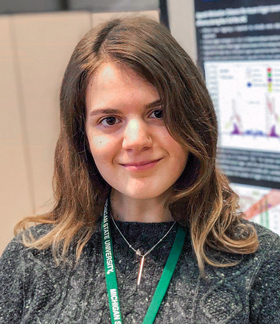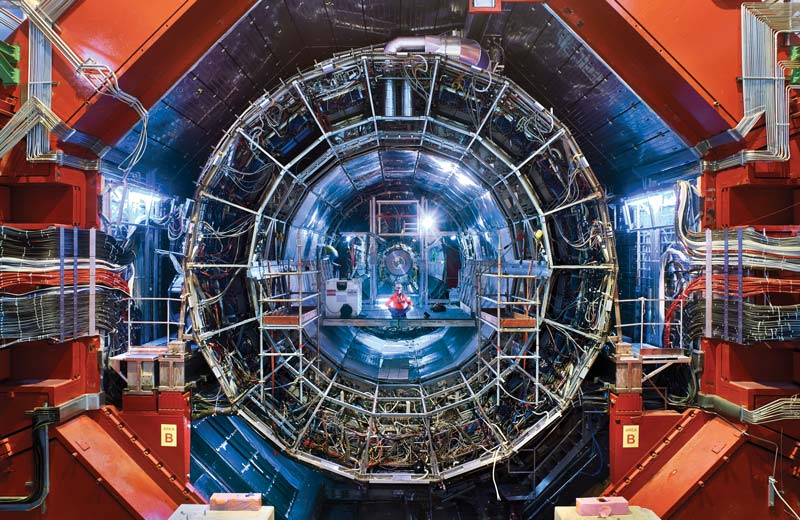Understanding Together
Spring
2019
Feature
Understanding Together
Alexis Mulski, SPS Member, University of Michigan
 In early February of 2018, I sat alone in a cold warehouse, hunched over a desk covered in a tangle of cables and wires. Adjacent to this warehouse was a building which once housed the experiment responsible for producing the first unambiguous signals of the W boson. I was testing electronics for the upgrade effort of the ATLAS experiment at the Large Hadron Collider (LHC) in Geneva, Switzerland. It was the beginning of my work on a project that entailed six months abroad and continues to this day.
In early February of 2018, I sat alone in a cold warehouse, hunched over a desk covered in a tangle of cables and wires. Adjacent to this warehouse was a building which once housed the experiment responsible for producing the first unambiguous signals of the W boson. I was testing electronics for the upgrade effort of the ATLAS experiment at the Large Hadron Collider (LHC) in Geneva, Switzerland. It was the beginning of my work on a project that entailed six months abroad and continues to this day.
The experience and privilege of working at CERN can only be properly parsed in hindsight. After all, it’s not every day that you can walk over and gaze into the 50-meter-deep cavern in which a Nobel prize–winning discovery was made. The elation of figuring things out—that feeling of finally truly understanding something—is unrivaled. But after a while, even exciting, important research took on the drudgery of any other daily task. The inevitable obstructions mounted, and frustration built. As the last vestiges of excitement about my new adventure began to fade, the appeal of working alone (“blazing your own trail,” as it’s often romanticized) went with it. Even though I knew I was doing important work, it felt like something was missing.
Then came spring, breathing new life into that cold facility. I attribute this less to the warming weather and more to the emerging presence of people—undergraduates, research scientists, postgraduates, and technicians, who were all returning to CERN after the cold Swiss winter. It didn’t matter that we all did not share the same language. We communicated problems and solutions through gestures, drawings, and facial expressions. Even those who I did not work with directly, extended their expertise and services without hesitation. My personal success became inextricably tied to theirs. We had a problem to solve, no matter the constraints.
In this way, scientists working on multinational collaborations are like athletes on a sports team. Even the most talented athlete can’t succeed alone. One must be trained and mentored, growing under the coaching of an advisor. Research collaborations of all sizes exist because we believe that being a scientist is a transferable skill that can be taught. Mentees learn from their advisors, and the cycle repeats. Besides, no one person could build a machine that probes matter at distance scales of 10-19 meters. In order to advance the field of high energy physics, we no longer have a choice. Together we can go farther than we ever could alone—and there is no going back.
The investigation of the “big” questions—regardless of whether or not it yields discoveries or develops technologies directly applicable in society—is an honorable human pursuit. Even if the LHC makes no headline-worthy discovery in the next 20 years of anticipated operation, it will not have failed. The LHC is the culmination of decades of work at CERN. At its inception in the 1950s, CERN united the physics community in the uncertain climate of the early postwar era. People from many nations, very recently out of conflict, were working together constructively to achieve a common goal rather than aiding in each other’s destruction. The experiments conducted at CERN have always been equal parts social and physical in nature.
The recently announced conceptual design report for the Future Circular Collider (FCC) at CERN reflects the achievements of LHC as the first worldwide science initiative. However, in order to build a machine of even greater energy and intensity, we will require an even larger team.
The late Carl Sagan once said, “The brain is like a muscle. When we use it we feel very good. Understanding is joyous.” But perhaps the Sagan quote misses the essence of what it means to work on a machine like the LHC: Rather than understanding things alone, understanding them together brings the most joy. 
